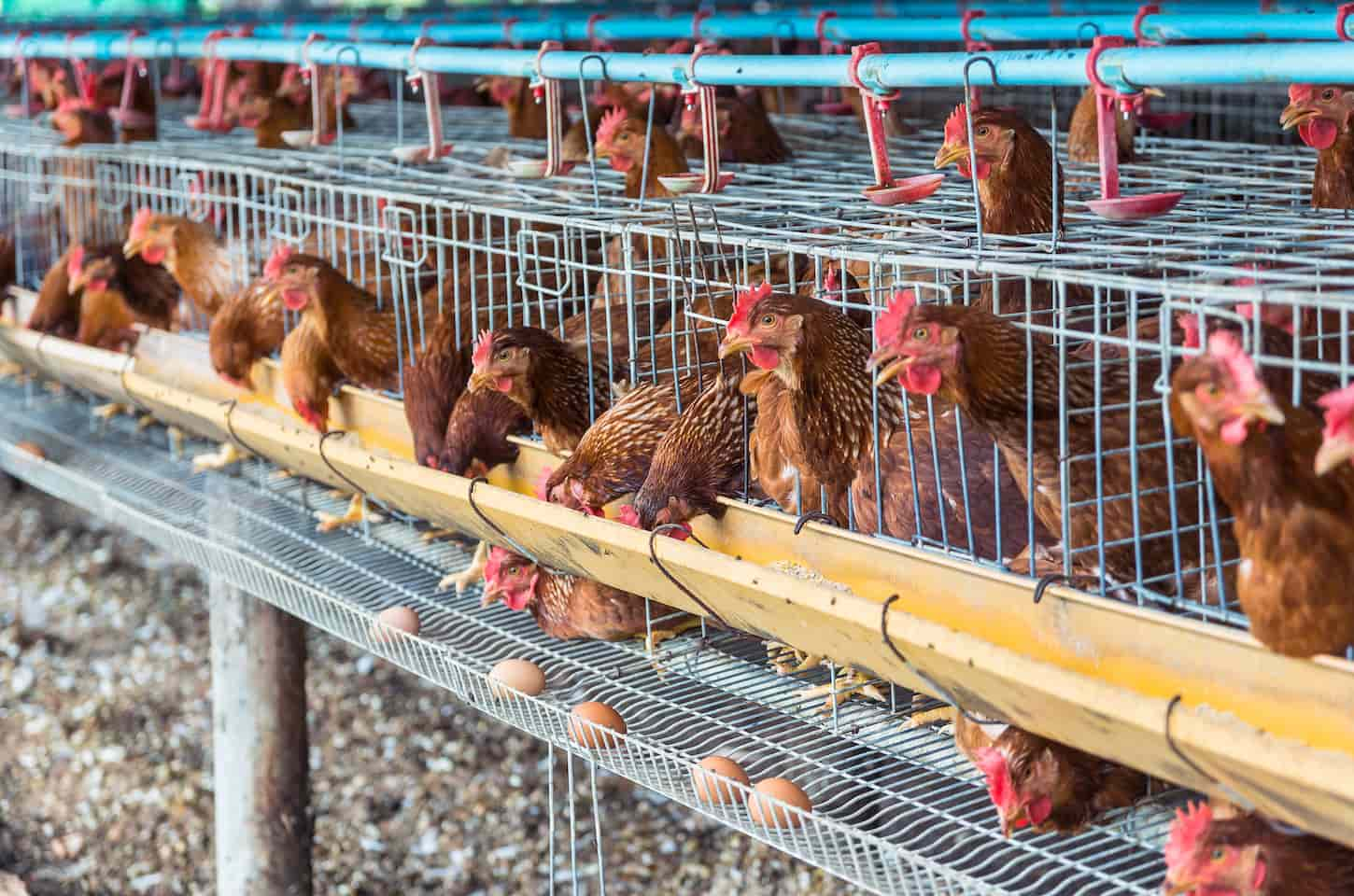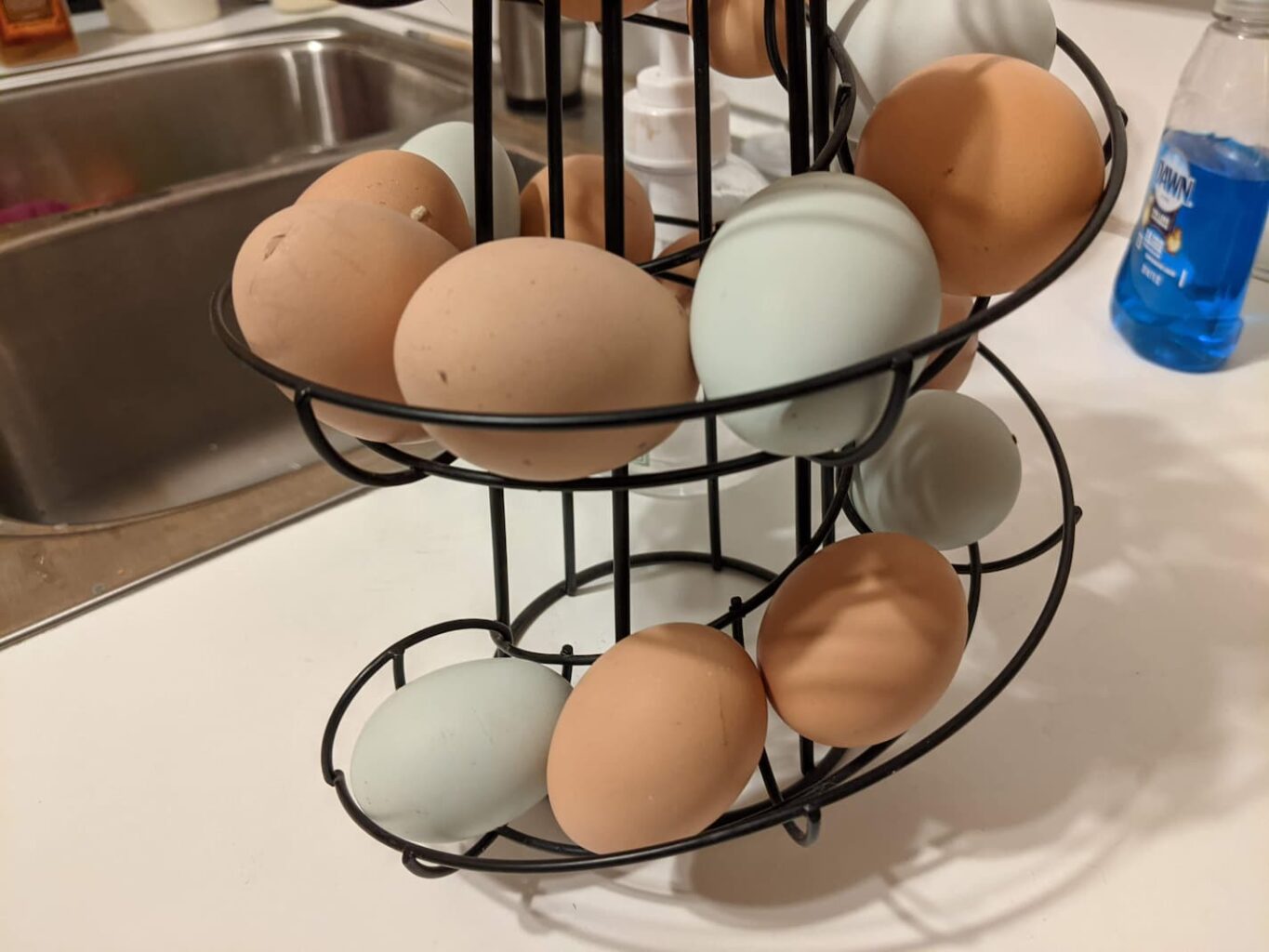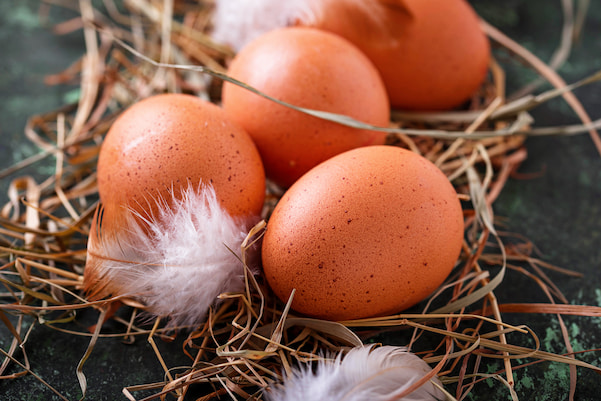If you find a deformed egg in your chicken’s nests then usually there isn’t any reason for alarm. It’s natural for a chicken to produce a misshapen or imperfect egg every now and then. And the important thing to know as a chicken keeper in which deformed eggs are safe to eat and which ones aren’t.
Most deformed eggs are safe to eat. Safe-to-eat eggs include wrinkly or spotted eggs or ones with discolored shells. However, there are some deformed eggs, like shell-less or soft-shelled eggs, that shouldn’t be eaten as these can make people ill. When in doubt, do not eat a questionable egg.
So in this guide, we’re going to take a closer look at deformed eggs and what causes them. This way you’ll confidently be able to distinguish between the ones you can and can’t eat. But in order to cover all that, let’s start with a quick overview of the basics – how chickens lay eggs. That way, everything else will make sense.

How do Chickens Make Eggs?
It takes around 25 hours for a chicken to produce and lay an egg. Each egg starts as a yolk and travels down the oviduct where it’s wrapped in the egg white and shell. And eventually, it passes out through the chicken’s vent.
A chicken is born with thousands of ova in her ovaries. Each day she will release an ova which becomes the egg yolk. The yolk takes around four hours to travel down the oviduct to a place called the magnum.
In the magnum, the egg white, which is made up of lots of proteins, is wrapped around the yolk and the egg shape will form. The egg then enters the chicken’s shell gland.
In the shell gland, the egg is covered in many layers of calcium carbonate, and this is known as calcification. The color of the eggshell is added to the outer layers in the last two hours of production. And finally, the hen will release the egg through her vent during laying.
What Are Deformed Chicken Eggs?
Deformed chicken eggs come in many different shapes, colors, and sizes. You’ll find discolored ones or ones covered in raised spots and wrinkly, bumpy ones too. Inside, you can find deformities such as a double yolk, and double shell. Or in some cases, you won’t find a shell at all.
Deformed chicken eggs are quite common in the backyard and free-range chickens. This is because they have a more varied diet. And also because they’re generally more exposed to stress factors. Common stress factors in backyard chickens include temperature fluctuations and sudden loud noises, for example.
On top of this, commercial, hybrid laying hens have been specifically bred to produce large, “perfect” eggs. Whereas purebred hens are usually bred for their physical features instead of their egg quality.
Because producing an egg is quite a long and intricate process, then potentially many things can go wrong. And overall the eggshell and its contents are a good indicator of your chicken’s health.
Most of the time deformities are caused by some kind of stress in your chicken’s environment. Or because of an inadequate diet. So if you regularly find deformed chicken eggs then you need to find out the causes.
Here’s What Causes Deformed Eggs
Take a look at our table below to find out why your hen might be laying deformed eggs.
| Cause | Known Remedies |
|---|---|
| Breed of the chicken | Buy breeds known to lay good eggs. |
| Diet | Give your chickens a good variety of foods. |
| Illness | Call your veterinarian and/or cull sick birds. |
| Age | Keep your flock’s average age on the lower end. |
| Temperature | Keep your flock comfortable no matter the weather. |
| Parasites | Treat the flock for parasites and/or cull sick birds. |
| Stress | Remove problematic stressors. |
| Not Enough Grit | Provide plenty of grit for your birds. |
Now, that’s the quick version. Let’s go into a little bit more detail.
Cause #1: The chicken’s breed
Hybrid hens have been bred to produce large, uniform, “perfect” eggs.
Pure breeds will usually have more variation in their shells. And they’re more likely to produce deformed eggs.
Cause #2: A chicken’s diet
If chickens are malnourished then they won’t be able to produce good eggshells. Hybrid hens especially need maximum nutrition to produce their large, perfect eggs. Laying hens need a high-quality feed that’s high in phosphorus, trace minerals, vitamin D3, and calcium.
Cause #3: Illness
Several diseases can cause abnormalities in your chicken’s eggshells. These include:
- Infectious bronchitis (IB),
- Infectious laryngotracheitis (ILT), and
- Newcastle disease (NDV).
These can all affect the quality of eggs. Most poultry farmers will vaccinate their chickens against these diseases. If you think that your chicken is suffering from any of these illnesses, then you need to call your vet for advice.
Cause #4: A chicken’s age
Pullets (young hens under one-year-old) will often lay smaller eggs at first. This is because it takes their body a while to come to terms with the whole laying process. It can take a few months for a pullet to produce larger eggs.
The laying frequency and the quality of the eggshell will also decrease with age. This means that older hens are also more likely to produce deformed eggs.
Cause #5: Fluctuating or extreme temperatures
Fluctuating temperatures can dramatically affect the shape and quality of eggs. Hot spells during the summer are especially bad. In particularly hot climates, you may need to supplement your chickens with electrolytes in their water to help them produce good eggs.
If you want to read more about how weather affects hens, make sure you read my guide here: Does Weather Affect Chickens Laying Eggs? 17 Hen Secrets. In that article, I’ll share the exact temperature range that hens like for laying eggs. It’s not as bad as the research makes it out to be!
Cause #6: Parasites
Parasites such as roundworms can cause pointy-shaped eggs. And a large mite infestation can cause eggs with bloody shells.
Cause #7: Stress
If your chicken becomes stressed while she’s laying or producing an egg this can cause it to be deformed. Stress is a very common cause of deformed shells. And stress can be caused by a huge range of environmental factors such as loud noises, bullying, or extreme temperatures.
Cause #8: Insufficient grit
Chickens need two types of grit.
- The first one is insoluble grit such as flint grit. This helps chickens to grind down their food because they don’t have teeth.
- And for shell production, they need a soluble grit such as oyster shells. This is high in calcium and will help your chickens produce good strong shells.
Your hens need grit so that they can produce good shells. So if they don’t have enough of it then this can cause problems with egg production.
If you can’t find good grit options locally, then you can find it on Amazon. For example, you can get this Manna Pro Poultry Grit with Probiotics on Amazon for a decent price, given that it’s being shipped right to your door.
But if you’ve got a local feed store? Definitely shop there, too. Odds are that you’ll get a much better price there on both insoluble grit and crushed oyster shell.
And seriously – if your chickens have access to dirt and small stones? You may not even have to buy insoluble grit – they can eat dirt and small stones to meet that nutritional need.

Which Deformed Eggs Are Safe to Eat?
In most cases, deformed eggs are safe to eat so there’s no need to throw them away. A lot of the time, the deformity is superficial to the shell. So this means that most discolored or bumpy eggs are just as nutritious as “normal” eggs.
Below we’ll take a closer look at the types of deformed eggs that are safe to eat.
Fairy Eggs
Fairy eggs are tiny little specimens and most of the time they don’t contain a yolk. These are usually laid by pullets when they’re just starting their laying career. Though they’re not very substantial, fairy eggs are safe to eat.
Textured Eggs
Sometimes you might find eggs with a wrinkly or uneven texture. When the egg white is too watery, the shell won’t form around it properly. So this can make the egg look wrinkly or bumpy.
This often happens with older, hybrid hens. And chickens who have suffered from infectious bronchitis also tend to produce wrinkled eggs. Even though they look quite strange, wrinkled and textured eggs are safe to eat.
White Spots or Hard Crust
If you find an egg with white spots or hard, crusty spots, then this is a sign of too much calcium or excessive vitamin D3. Excessive calcium forms hard, raised spots on the shell. These might be individual spots or lots of spots clustered together forming a crust. Eggs with white spots or a crust on the shell are safe to eat.
Double Yolk or Double Shell
Sometimes there’s a glitch in the egg-laying process. A yolk may get stalled in the oviduct or the magnum for a day. When this happens the result is two eggs in one. And you can tell this has happened if the egg has two yolks or two shells.
Eggs like these are often laid by young hens who are developing their laying technique. And double-yolked eggs or eggs with two shells are completely safe to eat.
Bloody Eggs
Sometimes you might find blood on the shell or in the yolk of an egg. A spot of blood in the yolk is called a meat spot. This indicates a tiny blood vessel has burst in the oviduct. People often mistake a meat spot for a developing embryo. However, a fertilized egg yolk will have a white spot rather than blood.
You might find blood on the shell of an egg too. This can be caused if your chicken’s vent is overstretched, especially when they’re just starting to lay. Or if they lay a particularly misshapen egg. An occasional bloody shell is no cause for concern. But if you find eggs with a lot of blood on them over consecutive days you must make sure that this isn’t caused by a prolapsed vent.
Eggs with small, bloody meat spots are safe to eat, as are eggs with blood on the shells. Just be sure to wash the blood off the shell before using them.
Discolored Eggs
Eggs come in a huge range of colors ranging from white to brown to pretty speckles. But sometimes you might find unusual stripes or patches of color on your eggs.
Discoloration can be linked to a range of factors including diet. And sometimes multiple colors occur because two shells have fused together in the shell gland pouch during production. It’s generally completely safe to eat discolored eggs.

Which Deformed Eggs Should NOT Be Eaten?
There are some deformed eggs that you shouldn’t eat because they can make you very ill. In all cases, if the shell is cracked or broken, you shouldn’t eat the egg. And if you’re unsure about the egg, then stick to the age-old saying: “if in doubt, throw it out.”
Odd or misshapen eggs, as long as they’re not rotten, can be fed back to your chickens. But you should cook the eggs first. This is because you don’t want to give your chickens a taste for raw eggs.
In my experience, scrambling eggs is a perfect way to cook eggs for chicken consumption because it prevents your chickens from getting a taste for raw eggs – and it’s not going to take a ton of time or effort on my part.
Below, we’ll take a look at the types of deformed eggs you shouldn’t eat.
Do NOT Eat #1: Shell-less or Soft Shelled Eggs
You shouldn’t eat eggs with a softshell or ones that don’t have a shell at all. This is because the shell provides a protective barrier between the egg and bacteria. So without the shell, the egg is exposed to all kinds of nasty organisms that you shouldn’t eat.
A hen will lay an egg without a shell if she has been subject to stress during laying. If she repeatedly lays shell-less eggs then this would indicate a problem in her diet. The first thing a shell-less egg would suggest is a lack of calcium, vitamin D3, or phosphorus.
Do NOT Eat #2: Lash Egg
A lash egg is a very strange-looking type of egg and your instinct alone would tell you that you mustn’t eat it. It’s really quite ugly and scary-looking.
A lash egg isn’t really an egg. Instead, it’s actually a build-up of infectious puss and tissue which can be soft or hard. This is a sign of an infection called Salpingitis. And if your hen lays a lash egg, then she will need treatment from your veterinarian.
Do NOT Eat #3: Rotten Eggs
These aren’t technically deformed but it’s a really unpleasant experience when you open one. The smell is rancid and it can knock your confidence (and your nose) when it comes to eating eggs. To check to see if an egg is rotten then do an egg freshness test.
How to Do an Egg Freshness Test
To find out if your eggs are fresh, then float them in a bucket of water. If the eggs float, then this means that they’re bad and you shouldn’t use them. A fresh egg will sink to the bottom and stay there on its side. An egg that’s a few days old will stay sunken but one end of it may rise.
This isn’t a 100% guarantee, but it works most of the time and people have been using this technique to test eggs for centuries.
I’ve tested our home-laid eggs, and they can stay fresh for up to several months. I’ve checked them via both a float test and by cooking and eating them (no, I didn’t get sick – and they were still delicious!).
Pro tip: If in doubt then throw it out. It’s not worth getting food poisoning over an egg.
What Should I Do If a Chicken Produces a Deformed Egg?
It’s normal for a young chicken to lay abnormal eggs for the first few months. And mature hens will lay deformed eggs for various reasons from time to time. And usually, there’s no cause for alarm unless it becomes a regular or problematic thing.
However, if an adult hen lays an abnormal egg for three or more consecutive days, then you should speak to your vet as it could indicate underlying health or environmental problems. And I’d recommend that you discard those eggs rather than eat them or even feed them to an animal.
FAQ About Deformed Eggs
Are eggs with rough shells safe to eat? Eggs with rough shells are safe to eat. And in most cases, rough shells are caused by excessive calcium or vitamin D3 in your chicken’s diet. This is especially true if it looks like the shell is covered in a hard crust.
Are eggs with bumpy shells safe to eat? It’s ok to eat eggs with bumpy shells. Often bumpy shells are caused by an irregularity in the hen’s oviduct or magnum. Sometimes two shells can fuse to create a bumpy texture. And if the egg white is too soft then the shell will look wrinkled.
Conclusion
If you find a deformed egg, it can be quite alarming at first. But, now you can see that there’s usually no need to worry.
Deformed eggs are common in older and very young chickens. And in most cases, they’re totally safe to eat.
If they’re too ugly or scary for you, then you could probably still feed it back to your animals safely. Make sure they’re cooked first, just to be safe. And don’t forget to let the food cool before feeding it to your animals!
The only time you should worry about deformed eggs is if your hen produces one several times in a row. In that case, keep track of what’s going on – both in the weather and conditions around your coop.
Then, consider calling your vet for advice because it could indicate a health problem. And because you’ve got the data about what’s been going on? It’ll help your vet give you the best possible next steps to take.
And just in case you’re wondering what to read next, almost every chicken keeper experiences a drop in eggs during the hottest part of the summer. So make sure you fix those potential issues by reading and implementing the tips I share in this article: How to Keep a Chicken Coop Cool in the Summer.
Go give it a read next. It’ll save you a lot of headaches and wondering why your chickens aren’t laying during peak production times.
Resources
Learning from your own experience is essential, but learning from others is also intelligent. These are the sources used in this article and our research to be more informed as homesteaders.
- Fletcher, Jenna. “How to Tell If Eggs Are Still Good.” Medical News Today, 18 May 2019, www.medicalnewstoday.com/articles/325210#float-test.
- “The Float Test: Do You Know How to Tell If an Egg Is Fresh?” The Irish Times, 9 Apr. 2019, www.irishtimes.com/life-and-style/food-and-drink/the-float-test-do-you-know-how-to-tell-if-an-egg-is-fresh-1.3854365.
- “Soft-Shell or Misshapen Eggs | Beauty of Birds.” Beauty of Birds, www.beautyofbirds.com/eggproblems.html.
